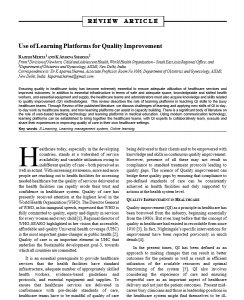
Healthcare today, especially in the developing countries, stands at a watershed of service availability and variable utilization owing to indifferent quality of care – both perceived as well as actual. With increasing awareness, more and more people are reaching out to health facilities for accessing needed healthcare but the quality of services delivered at the health facilities can rapidly erode their trust and confidence in healthcare system. Quality of care has presently received attention at the highest level in the World Health Organization (WHO). The Director General of WHO, in his inaugural speech, expressed that WHO is fully committed to quality, equity and dignity in services for every woman and every child. Regional director of WHO-SEARO highlighted in her vision that accessible, affordable and quality Universal health coverage (UHC) is the most important game-changer in public health. Quality of care is an important element in UHC that underlies the Sustainable development goal-3, towards which all countries are committed.
It is an essential prerequisite to provide healthcare services that the health facilities have standard infrastructure, adequate number of appropriately skilled health workers, evidence-based guidelines and protocols, and essential equipment and supplies. To ensure that healthcare services are delivered in conformance with pre-decide standards of care, healthcare teams have to be mindful of quality of care being delivered to their clients and to be empowered with knowledge and skills in continuous quality improvement. However, presence of all these may not result in compliance to standard treatment protocols leading to quality gaps. The science of Quality improvement can bridge these quality gaps by ensuring that compliance to pre-defined standards of care can be consistently achieved in health facilities and duly supported by actions at the health system level.
—
This special issue of Indian Pediatrics (September 2018; Volume 55: Number 9) highlights mechanisms that can support health care providers in using various quality improvement (QI) approaches and showcases some of the improvement projects undertaken in India by different teams.
The USAID ASSIST Project started working in India in September 2013; initially working directly with districts and facilities to help them learn how to use QI approaches to save lives. This work went well and the staff in these facilities were able to reduce perinatal mortality by 15% over 18 months. During this time, we met great partners from important organizations and institutions across India.
These institutions are now leading a growing movement to help more people apply QI methods to deliver care that prevents harm, improves outcomes, and meets the needs of the people receiving it through their own networks using domestic funding; continuing these lifesaving efforts after ASSIST technical support has ended.
The supplement shows important results of the ongoing QI work in these networks and shows how domestic QI networks, earlier supported by ASSIST, are now independently supporting and spreading the use of QI methods to provide better care.